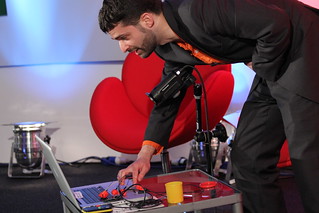I love the idea that the world around us isn’t a fixed, objective thing; instead it has appeared to us very differently at various stages of history. Over time technology has not only shaped the world but changed our relationship with it. We have altered the natural environment so much that some geologists have termed this a new geological era (the Anthropocene), but I am more interested in how our interactions with the world are mediated by technology. It’s not just the world that we’re changing, it’s the way we experience it.
At the event we looked at this effect across the whole timeline of our history. Bran Ferren talked about the very first technologies, including language, the wheel and the ability to make fire. These were among the first things that enabled us to start shaping the world around us, rather than just being determined by it. Before these things, we were almost entirely at the mercy of our environment. The weather and landscape determined what we did and where we could survive. Early technologies were the first means to turn that around and control the environment instead: if it was cold and dark, we could create warmth and light. We could barter using language. We could expand the world of our experience by travelling longer distances on wheels. We started to experience the world not just as something that controlled us, but as something we could control.
If you look at it that way, technology has always been the interface through which we experience the world. As it has become more advanced it’s incredible how it has changed the relationship we have with things around us. Andrew Blake demonstrated the Kinect technology that he and his team developed for Xbox. A Kinect sensor was used to scan Tom Standage on stage, creating a real-time, moving 3D image of Tom on a screen. They were then able to superimpose things onto the image, blending reality with computer-generated objects. A computer-generated bucket of polystyrene balls was tipped over Tom’s head, and when Tom moved to “brush them off”, off they came onto the floor.
We can augment reality in more useful ways too – you can download an app onto your phone to see data overlaid on the world around you. If you view the street in front of you through your phone camera as you walk down it, you can see both the street and information about the street at the same time – the opening hours of that restaurant, the name of that historical building, even the names of constellations in the sky ahead of you, depending on the app you’re using. Technology is literally altering the way we perceive what’s around us.
Esra’a Al Shafei talked about technology that is changing people's relationship with the political environment (MideastYouth.com), Aleks Krotoski talked about social networks that are changing our relationships with each other, and Hugh Herr talked about enabling physically or mentally disabled people to engage with the world around them more easily. One of the most fun examples of using technology to change how we interact with the world was from Eric Rosenbaum. He plugged bananas into his computer and bashed them to play different musical notes like the keys on a piano. He used playdough and pencil drawings to control a game of Pac-Man. He asked Cory Doctorow, Aleks Krotoski and Mark Stevenson to hold a bit of playdough each, used crocodile clips to plug them into his computer, then played the three of them like a human synth. That was one of the most bizarre things I’ve seen on stage, and it was a nice reminder that as technology keeps advancing we’ll only be limited by our imaginations.





